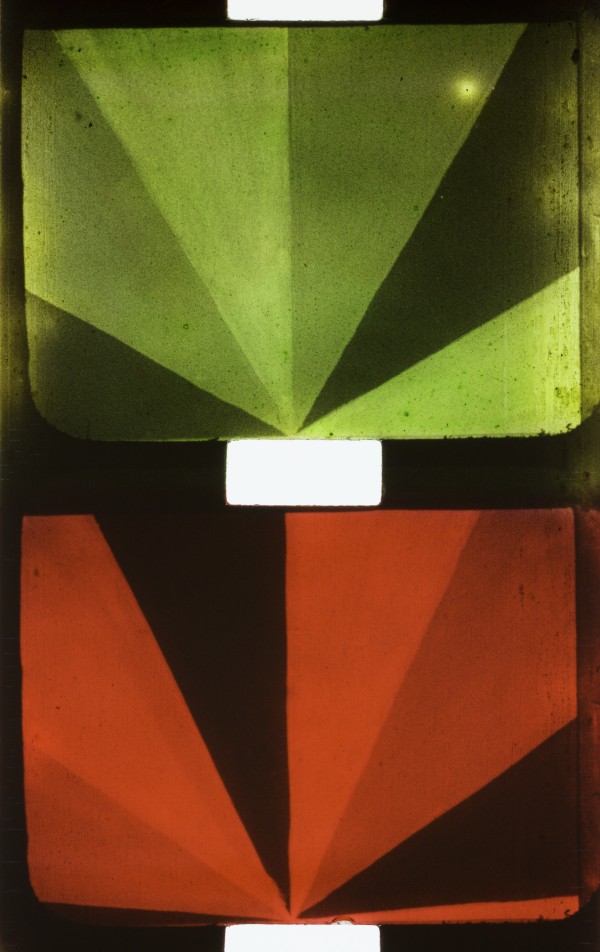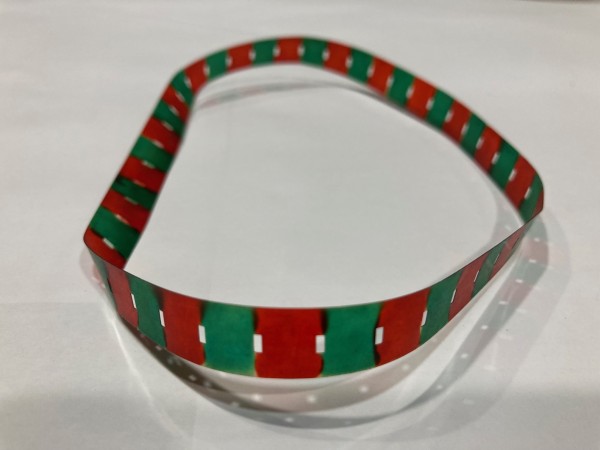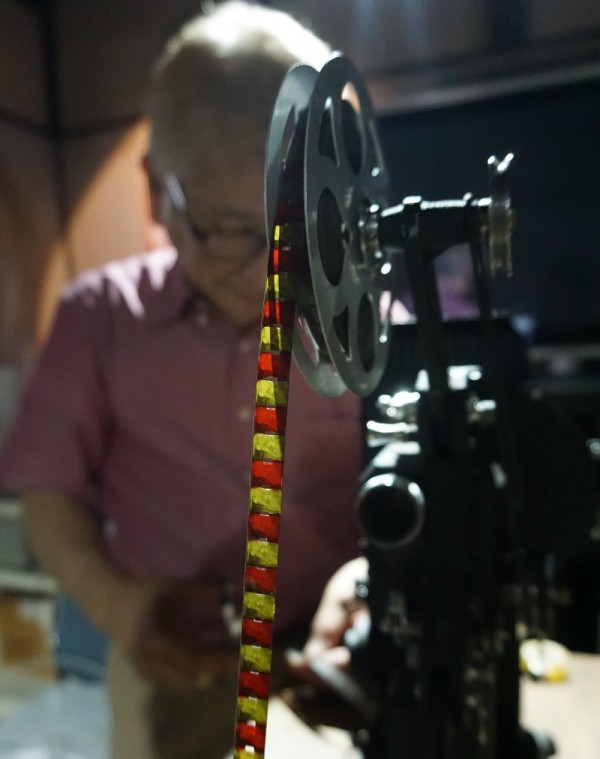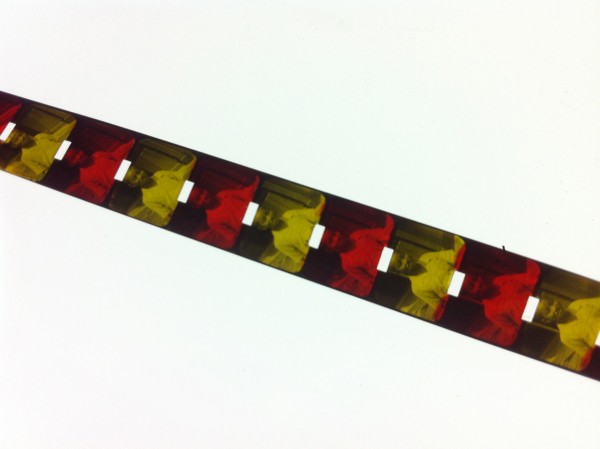An additive color system for 9.5mm film, invented by Sadatomo Tachibana, a Japanese amateur filmmaker. Variations on this system were used by other Japanese amateur filmmakers throughout the 1930s.
Film Explorer

A 9.5mm original reversal copy of the experimental amateur film An Expression (1935). Alternate frames were photographed and colored red and green. During projection, a crude color image was revealed. This film used a variation of Tachibana’s natural color system; the projection copies were the same, but the shooting method was different.
National Film Archive of Japan, Tokyo, Japan. Photograph by Barbara Flueckiger. https://filmcolors.org/galleries/an-expression-hyogen-1935/
Identification
Likely 8.2mm x 6.2mm (0.323 in x 0.244 in).
Approx.
From 14 fps to 32 fps.
1, or 2.
Alternate frames were hand-colored red and green.
None
8.5mm x 6.5mm (0.335 in x 0.256 in).
Pathé Baby. A central rectangular perforation (2.4mm x 1mm [0.095 in. x 0.039 in]) between each frame.
B/W, panchromatic, reversal, Pathé and Gevaert.
Varies depending on manufacturer.
History
This process was invented by Sadatomo Tachibana (Tokyo, 1902–1971), an amateur filmmaker and president of Kogata Eiga Kyokai (Small Gauge Film Society), who was also known as a biwa (Japanese lute) player under the stage name Kyokuo Tachibana III. This additive two-color system was first noted in the April 1933 issue of Nippon Pathé-cine (Nippon Pathé-cine kyokai) in an article titled “Pathé-Baby Natural Color Filmmaking Method”. Tachibana’s technique was influenced by Kinemacolor, a 35mm British additive color system introduced in the 1910s and screened in Japan at that time.
The same issue of Nippon Pathé-cine also carried an article by Hayao Yoshikawa (Tokyo, 1890–1959) and Shigeji Ogino (Tochigi, 1899–1991) on the production of ten’nenshoku [natural color] film on 9.5mm film. Tachibana’s 9.5mm color film process was shown in October 1935, at an exhibition on the progress of ten’nenshoku film held at the National Museum of Nature and Science, Tokyo.
Several other amateur 9.5mm natural color films were made using this process that still survive, as well as a 16mm natural color film directed by Ryua Imaeda, called Mickey and the Gorilla (1935), which was modeled after Tachibana’s process.
In 1930s Japan, 16mm and 8mm color film processes, such as Kodacolor and Kodachrome, did not become widely adopted because they were expensive, imports were limited and 9.5mm film was much more widely in use. Although there were not many films made using Tachibana's system, Shigeji Ogino rated it highly in the October 1935 issue of Nippon Pathé-cine, writing that anyone could now easily make natural color films. Home movies in 9.5mm, using Tachibana’s system, have been discovered by the Toy Film Museum in Kyoto and Kobe Planet Film Archive.
Selected Filmography
Screened in October 1935 at National Museum of Nature and Science, Tokyo and other places. Sadly, none of Sadatomo Tachibana’s 9.5mm color films are known to exist today.
Screened in October 1935 at National Museum of Nature and Science, Tokyo and other places. Sadly, none of Sadatomo Tachibana’s 9.5mm color films are known to exist today.
A home movie, conserved at Kobe Planet Film Archive, Kobe, Japan.
A home movie, conserved at Kobe Planet Film Archive, Kobe, Japan.
A home movie shot at 16 fps. Conserved at Kobe Planet Film Archive, Kobe, Japan.
A home movie shot at 16 fps. Conserved at Kobe Planet Film Archive, Kobe, Japan.
Screened in October 1935, at the National Museum of Nature and Science, Tokyo.
Screened in October 1935, at the National Museum of Nature and Science, Tokyo.
Screened in October 1935, at the National Museum of Nature and Science, Tokyo.
Screened in October 1935, at the National Museum of Nature and Science, Tokyo.
A short graphic animation, conserved by the National Film Archive of Japan. This film used a variation of Tachibana's system, but with a different shooting method. Winner of the international competition, St. Teccian Cup in Budapest, Hungary.
A short graphic animation, conserved by the National Film Archive of Japan. This film used a variation of Tachibana's system, but with a different shooting method. Winner of the international competition, St. Teccian Cup in Budapest, Hungary.
Technology
The Tachibana 9.5mm Natural Color process was a sequential-frame, two-color additive system similar to Kinemacolor. It required film stock which was sensitive to the full spectrum of visible light for shooting – trials only became possible when 9.5mm panchromatic film, made by Pathé and Gevaert, was imported to Japan in the 1930s.
A loop of short, transparent 9.5mm film with blank frames colored alternately red and green was set in the camera magazine so that it was in contact with the emulsion side of the unexposed B/W panchromatic film. Light entering the camera passed through this moving loop of film and frames were filtered alternately red and green on the B/W film behind it. The dyes Safranin red and methyl-green were considered suitable. The length of the loop was 40 frames when used in a Motocamera type A.
To reduce heavy, visible flickering, the shooting speed was increased to 32 fps, which was twice as fast as the standard for 9.5mm spring-driven cameras available at the time. To accomplish this faster speed, the motor in the camera was adjusted, or the camera was cranked at a faster rate, although Tachibana also experimented with frame rates as low as 14 fps. The images captured on the film were close to those of conventional red and green color separation filters.
There were two methods of film projection:
• Projection through a loop of film, colored in the same way as the loop in the camera, with red and green frames corresponding with the same frames of the B/W reversal projection copy, thus revealing the color on screen.
• Direct colouring of the film itself, red and green for each alternate frame – often hand-painted directly on to the film.
In both cases, the film was projected at nearly twice standard speed. This high frame rate had the effect of blending the red and green frames into a crude color image on the screen. Nevertheless, a heavy flicker was perceptible in the final image, due to the red and green frames presenting independently on the screen.
Another disadvantage was the loss of projection light due to absorption by the colored-loop filter. This was not a problem for short projection throws at home, but, in larger venues, the dimmer projected image was potentially problematic. The problem of less light reaching the screen could be addressed by using a projector with a brighter, more powerful lamp, or by adjusting the exposure of the film, during the development process.

The 9.5mm, two-color filter loop that was placed inside the camera magazine, in contact with the raw film being exposed.
Toy Film Museum, Kyoto, Japan. Photograph by Yoneo Ota.

How the looped film with red and green dyed frames was loaded and used as a two-color filter in a 9.5mm camera magazine. The loop film was positioned through a groove in the Pathe-Baby camera magazine, so that it was placed outside of the raw film.
Imaeda, Ryua (1933). “Special feature: Pathe 9.5mm natural-color filmmaking method”. Nippon Pathe-cine [Japan Pathe-cine Association] (April): p. 36.

Yoneo Ota, director of the Toy Film Museum, Kyoto, sets up a Tachibana color film on a 9.5mm Alma projector.
Toy Film Museum, Kyoto, Japan.
References
Anon. (1933). “Pathé-Baby natural color filmmaking method” (Tokushu Pathé kumirihan ten’nenshoku eiga seisaku ho)”. Nippon Pathé-cine, 4 (May–October): pp. 23–37.
Imaeda, Ryua (1933). “Special feature: 9.5mm natural-color filmmaking method (Tokushu: 9.5mm no ten’nenshoku eiga seisaku ho)”. Nippon Pathe-cine (May–October): May, pp. 52–62; June, pp. 64–76; July, pp. 38–46; August, pp. 28–36; September, pp. 80–88.
Kazuho Inagaki (1935). “Natural colour film development exhibition (catalogue) (Ten’nenshoku eiga hattatsu chinretsu kai [catarogu])”. Tokyo: National Museum of Nature and Science (Shizen kagaku to hakubutsukan): pp. 12–29.
Osawa, Shofu (1936). “Knowledge of natural-color films” Nippon Pathe-cine (Jan): pp. 26-45.
Toy Film Museum (n.d.). “Kinemacolor system (Kinemakarā hōshiki no eizō)”. Toy Film Museum, Kyoto (accessed March 16, 2024) https://toyfilm-museum.jp/news/infomation/1633.html
Patents
None
Compare
Related entries
Author
Sadanobu Iida is a small-gauge film researcher. Sadanobu worked for 10 years as an assistant cinematographer and SFX/VFX technician at Shirogumi Inc., involved in the production of commercial animations. He is the author of Report: Senzen kogata eiga shiryo shu (Film Preservation Society: Small Gauge Dept, 2009), Toy Film Museum Booklet 3: The Age of Pathé-baby (co-authored with Noriko Morisue, Toy Film Museum, 2017), supervisor of 9.5mm films for TV drama and the theatrical release version of Wife of a Spy (2020), directed by Kiyoshi Kurosawa. He supervised the film equipment collection for the launch of the website opened in 2023 called “Film Heritage – National Film Archive Film Material Portal” (https://nfajfilmheritage.jp).
Yoshio Yasui, Taichi Kinugawa.
Iida, Sadanobu (2024). “Tachibana 9.5mm Natural Color Film”. In James Layton (ed.), Film Atlas. www.filmatlas.com. Brussels: International Federation of Film Archives / Rochester, NY: George Eastman Museum.
Kae Ishihara



